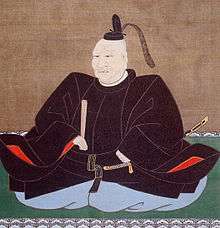Tōdō Takatora
| Tōdō Takatora | |
|---|---|
 Tōdō Takatora | |
| First Lord of Imabari | |
|
In office 1600–1608 | |
| Preceded by | none |
| Succeeded by | Matsudaira Sadafusa |
| First Lord of Tsu | |
|
In office 1608–1630 | |
| Preceded by | none |
| Succeeded by | Tōdō Takatsugu |
| Personal details | |
| Born |
February 16, 1556 Tōdō Village, Ōmi Province, Japan |
| Died |
November 9, 1630 (aged 74) Edo, Japan |
| Nationality | Japanese |
Tōdō Takatora (藤堂 高虎, February 16, 1556 – November 9, 1630) was a Japanese daimyō from the Azuchi–Momoyama to Edo periods. He rose from relatively humble origins as an ashigaru (a foot soldier) to become a daimyō. During his lifetime he changed his feudal master seven times and worked for ten people, but in the end he rendered loyalty to Tokugawa Ieyasu, who became his last master.[1][2]

Tōdō Takatora was promoted rapidly under Hashiba Hidenaga, the younger brother of Toyotomi Hideyoshi, and he participated in the invasions of Korea as a commander of Toyotomi's fleet. His fiefdom at that time was Iyo-Uwajima. During the Edo period, the wealth of each fiefdom was measured as a volume of rice production in koku. Iyo-Uwajima was assessed at 70,000 koku.[1][2]
At the Battle of Sekigahara in 1600, although he was one of Toyotomi's main generals, he sided with Tokugawa Ieyasu. After the war he was given a larger fiefdom, Iyo-Imabari, assessed at 200,000 koku. Later in life he was made lord of Tsu (with landholdings in Iga and Ise), a domain of 320,000 koku.
After the death of Akai Naomasa, some members of the Akai clan became retainers to the Tōdō house.[3]
Tōdō Takatora is also famous for excellence in castle design. He is said to have been involved in building as many as twenty castles.[1][2]
In fiction
- Takatora is a playable character in the Samurai Warriors franchise debuting in Sengoku Musou Chronicle 2nd. In Samurai Warriors 4, he is portrayed as an Azai retainer and a close friend of Yoshitsugu Ōtani before joining the Toyotomi.
References
- 1 2 3 "戦国 出世の方程式 ~藤堂高虎 大坂夏の陣の大勝負~、日本放送協会 (The formula for promotion in the Sengoku ages, Todo Takatora's Challenge in the Osaka Castle Summer War, by NHK" (in Japanese). Retrieved 2007-03-27.
- 1 2 3 "津市 文化課 藤堂高虎 (The city of Tsu official homepage)" (in Japanese). Retrieved 2007-03-27.
- ↑ "SamuraiWiki". Samurai Archives. Retrieved 2012-07-15.
- Tōdō family information (25 Sept. 2007) (Japanese)
External links
- Momoyama, Japanese Art in the Age of Grandeur, an exhibition catalog from The Metropolitan Museum of Art (fully available online as PDF), which contains material on Tōdō Takatora
| Preceded by none |
First Lord of Imabari 1600–1608 |
Succeeded by Matsudaira Sadafusa |
| Preceded by Tomita Nobutaka |
First Lord of Tsu 1608–1630 |
Succeeded by Tōdō Takatsugu |
External links
- Works by or about Tōdō Takatora in libraries (WorldCat catalog)